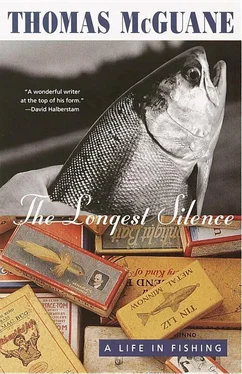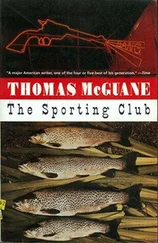A squadron of permit appeared on the flat, feeding steadily, tips of dorsals and tails making incisions in the slick water, their deep bodies taking on their surroundings as they moved. At a range of about a hundred feet, Gil began to position the skiff. I checked and rechecked the loose fly line on the deck, made my best effort at estimating our closing speed, and raised my rod to begin casting. The fish exploded in the general direction of Mexico.
With this slick, transparent water, we were hoping for intent, feeding fish. Any fish that looked up at all was bound to see us. We hoped, too, for an afternoon breeze that never came. Instead we found through this long day numerous permit, some of very substantial size, but all well out of reach; some simply dematerialized in the glare. They induced futile casting, among other defiant gestures; so when the water jug was empty and the last Cuban sandwich swallowed, we felt as far from catching a permit as we had when we began.
To pass the time, Gil and I talked about how we’ve changed the way we fish for permit. The flies are heavier and more realistic. We cast much more directly to the fish, as close as possible, instead of the long leads we used to throw out for fear of spooking them. Knowledge of tides and seasons, as well as the extremely specific “trails” used by permit, has improved. Catching a permit on a fly has gone from nearly impossible to extremely difficult. The fish are around in good numbers, thanks to a persistent practice of releasing them. Key West remains at the center of stateside permit fishing, and if the attempt to ban Jet Skis from the White Heron National Wildlife Refuge is successful, we may look to a long future for this exalted fishery.
The breeze picked up the next day and our ability to reach the fish rose accordingly. Of course the wind makes accurate casting harder. And there were fewer fish around. One fish after another refused the fly; several lifted in the chop as I cast, and saw the boat; another tried to tail on the fly but lost it in the grass. And then the sun went down. Afterward, I drove into town to buy sandwiches for the next day at Uncle Garland’s. We went from Cuban Mix, to roast pork, to a belly-buster called the “Midnight Special.” So far, lunch was providing the only punctuation in the search for fish.
The third day enlarged our sense of struggle. The nice cobia I caught off the back of a stingray early on did little to mitigate our frustration. I had several opportunities through the long hot day and none of them came to anything. You find yourself looking at jet contrails, wondering when they’re going to open up Cuba, trying to remember the names of the bartenders at the Anchor Inn on Duval Street in 1971. The light was at a low angle and the cormorants were homeward bound. We crossed a shallow flat at the middle of which was a kind of trough. A nice permit was swimming up the trough with the lazy movements of a feeder; I could just make out the edge of fins around the deep, shadowy body. I made a cast and the fish responded. From his vantage point on the platform, Gil called out suggestions for working the fly. My hope was still low when I felt the slight tightening in my line. I struck and the fish streaked off so fast that I had loose fly line ten feet in the air. Once he was on the reel, a satisfying whirr from the drag indicated his progress throughout a long, fast first run. Fighting a permit is pure worry. I worried about my knots and about the line to backing splice I’d done the night before. I worried about the hinging effect, after hours of casting, on the knot at the fly. I worried that fishing with a barbless hook had been taking sportsmanship too far. I desperately wanted to land this fish.
I began to believe the permit was coming to the boat but at the range of sixty feet, he went on another wild run, this one ending in a dogged halt a long way off. Gil kept up our pursuit with the push pole and after a while the fish was a rod’s length from the starboard side of the skiff. But when Gil started for the net, the fish shot straight under the boat. I plunged the rod tip underwater to keep the line clear of the hull and waited for the fish to continue his run out the other side. He didn’t reappear. My hopes began to vanish. I reeled until the leader was inside the rod and felt the dread certainty that my leader had fouled on one of the trim tabs under the hull. I lay the rod down and hung over the transom. Below the hull, the tail of the permit projected, finning evenly, the leader fouled on the bottom of the boat. I had one chance left. I reached down and tailed the fish and lifted him into the boat with one motion. Caught! I felt the cool solidity and strength of the fish between my hands. After Gil removed the hook and eased the fish back into the water, I watched him surge off into the evening glare.
Tomorrow, we were going permit fishing.
I AM PASSIONATELY interested in Atlantic salmon, steelhead, and sea trout, all kin. More than any other fish, they have carried on their backs centuries of hare-brained theories and demented off-season reflection. Yet each of them have created different sport fisheries. Some are quite difficult, others are set up so that the well-heeled may be successful. Atlantic salmon fishers have fallen into several groups, of which the following is an incomplete list.
The Rich, Old and New
Awaiting a bush plane or gut-festooned aluminum outboard boat in flannels, cordovans, a signifying necktie or bowtie and the oddly imprisoning drapery of a J. Press blazer, these men often own the rivers they mean to fish. However, given the tedium of riparian owners’ meetings and unpredictable encounters with native peoples who are increasingly armed, if not with Kalishnikovs then with counsel, they sometimes have transferred ownership to the credulous and more recently well off, demonstrating once again how they have hung on to money for so long.
The newly rich aren’t discernible from the old by visual references. If they now often own the river, they seem left holding the bag by their predecessors who continue to exercise a sort of droit du seigneur through frequent visitation, on the theory that they add tone and continuity to the old camp. With experience at their backs, they can jubilantly outfish the new owners. Only loose tongues as to the odious rise of the Irish or the poor job done by land grant colleges can get their rod privileges pulled. So many of the children of the old rich have given up their club memberships and are now in rehab that this group of anglers is discovering a hard-won humility and is getting along with the new rich better.
Corporate Groups
These are growing more common. Say you’re on the edge of the tundra hoping to spot the great skua in his hunt of the arctic seas, when a Gulfstream jet, with the logo of a world-renowned widgetworks on its fuselage, lands in a cloud of jet exhaust, scattering caribou, penguins, and reindeer. The door opens, the stairway descends, and here they come! All hard-driving executives with new gear, they fly well below the radar of annual reports which do not reflect this use of the multi-million dollar aircraft. Shareholders know a G-3’s “out there” but they think it’s going to merger meetings or is being used as a kind of attack aircraft in hostile takeovers. Retirement-minded investors would be hard-pressed to imagine their benefactors at forty thousand feet, stretching nine-weight flylines in the aisle while Debbie Does Dallas plays in the little lounge area where the steward brings peanuts and cocktails, or relaxing in the always-open cockpit where you can sit with the pilots and study the gray seas below while pondering the mystery of salmon.
Time Sharers
Читать дальше












